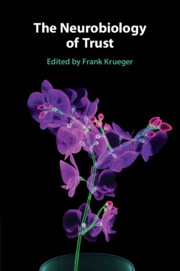Book contents
- The Neurobiology of Trust
- The Neurobiology of Trust
- Copyright page
- Dedication
- Contents
- Figures
- Tables
- Contributors
- Abbreviations
- Introduction
- Part I Fundamental Level of Trust
- Chapter 1 Trust and Psychology
- Chapter 2 Trust and Behavioral Economics
- Chapter 3 Trust and Digitalization
- Chapter 4 Trust and Human Factors
- Part II Neuropsychological Level of Trust
- Part III Neurocharacteristic Level of Trust
- Part IV Neuromolecular Level of Trust
- Part V Neuropathological Level of Trust
- Index
- References
Chapter 3 - Trust and Digitalization
Review of Behavioral and Neuroscience Evidence
from Part I - Fundamental Level of Trust
Published online by Cambridge University Press: 09 December 2021
- The Neurobiology of Trust
- The Neurobiology of Trust
- Copyright page
- Dedication
- Contents
- Figures
- Tables
- Contributors
- Abbreviations
- Introduction
- Part I Fundamental Level of Trust
- Chapter 1 Trust and Psychology
- Chapter 2 Trust and Behavioral Economics
- Chapter 3 Trust and Digitalization
- Chapter 4 Trust and Human Factors
- Part II Neuropsychological Level of Trust
- Part III Neurocharacteristic Level of Trust
- Part IV Neuromolecular Level of Trust
- Part V Neuropathological Level of Trust
- Index
- References
Summary
Determining whom to trust and whom not to trust has been critical since the early days of ancient civilizations. However, with the increasing use of digital technologies, trust situations have changed. We communicate less face-to-face. Rather, we communicate with other people over the Internet (e.g., Facebook) or we interact with technological artifacts (e.g., chatbots on the Internet or autonomous vehicles). This trend towards digitalization has major implications. It affects both the role of trust and how we should conceptualize trust and trustworthiness. In this chapter, insights on phenomena related to trust in a digital world are reviewed. This review integrates findings from various levels of analysis, including behavioral and neurophysiological. The structure of this chapter is based on four different scenarios of trust in a digital world that were developed by the author. Scenario A describes a technology-free situation of human-human interaction. Scenario B outlines a situation of computer-mediated human-human interaction. Scenario C denotes a situation of direct human-technology interaction. Scenario D refers to a situation of computer-mediated human-technology interaction. The common denominator of all situations is that a human acts in the role of trustor, while the role of trustee can be either another human or a technological artifact.
- Type
- Chapter
- Information
- The Neurobiology of Trust , pp. 54 - 76Publisher: Cambridge University PressPrint publication year: 2021
References
- 1
- Cited by

